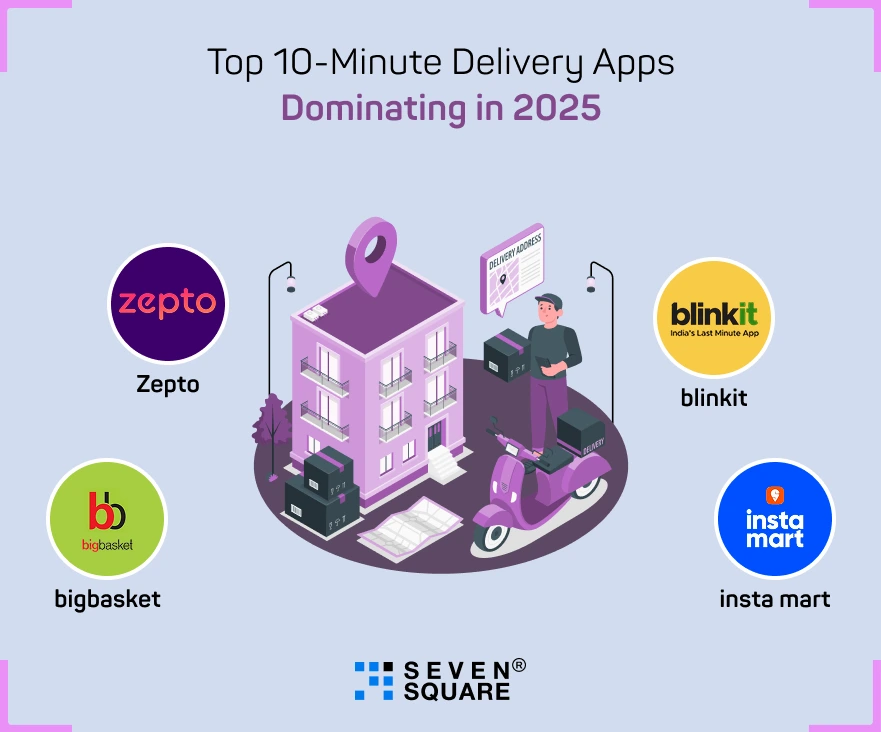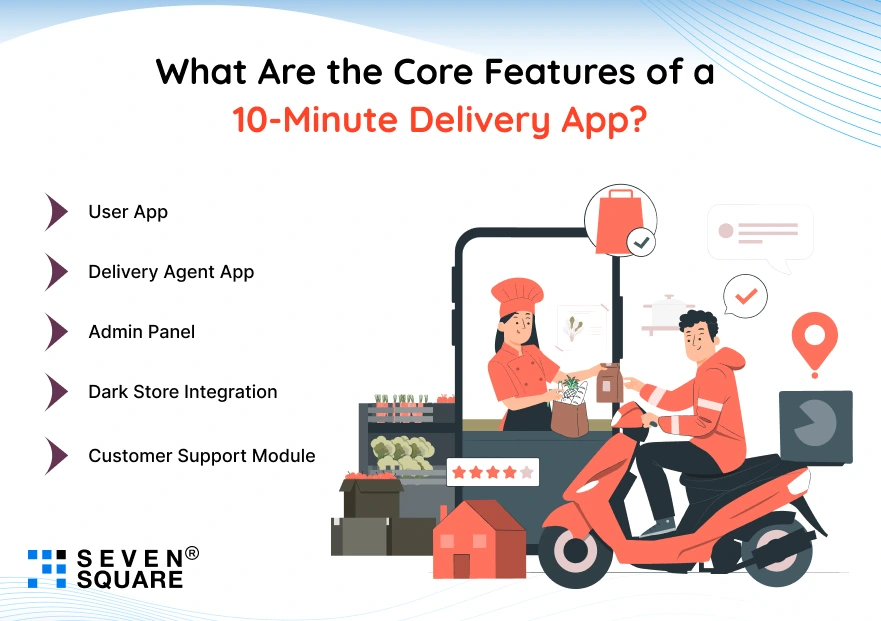You’re not imagining it, customers today expect their groceries in 10 minutes.
Not tomorrow. Not later tonight. Ten. Minutes.
That’s not a trend; it’s the new baseline for convenience.
Founders like you aren’t asking if you need a quick commerce app, you’re asking how fast you can go live with one.
We’ve seen it firsthand. Teams are scrambling to meet expectations.
Stakeholders demand speed and scale.
You want clarity on building a 10 minute delivery app that doesn’t just work but wins. Let’s cut the noise and break it down clearly.
Do you want to build 10 minute delivery app? You are at the right place, here you can learn about grocery delivery app development.
What is the Real Challenge Behind 10-Minute Delivery?
What makes instant delivery apps hard isn’t just tech. It’s logistics. It’s fulfilling. It’s user trust.
When a user taps “Buy Now,” they’re not just ordering eggs.
They’re buying into a promise: that your app, your team, your last-mile engine, all will deliver within minutes.
That’s where quick commerce apps differ from traditional eCommerce.
You’re not building Amazon. You’re building Zepto. Blinkit. Swiggy Instamart.
Learn more about Zepto’s MongoDB Migration.
These 10 minute grocery delivery apps rely on tight tech + dark store integration, real-time inventory, and serious location intelligence.
And here’s the kicker, if the experience is even a little off, they uninstall.
Top 10-Minute Delivery Apps Dominating in 2025

Before you build your own, it’s worth looking at the leaders in the q-commerce platform space:
- Zepto: The OG of 10-minute grocery delivery in India. Great UI, rock-solid backend.
- Blinkit: Seamlessly connected warehouses and hyperlocal delivery.
- Swiggy Instamart: Leveraging food delivery logistics for fast groceries.
- BigBasket Now: On-demand inventory, local delivery partnerships.
These apps prove it: people don’t just want groceries fast, they want them now.
What Are the Key Features of a 10-Minute Delivery App (and How to Build Them Right)?
A 10-minute delivery app lives or dies by its execution. Every feature must reduce friction and drive reliability. Here’s what matters:
1. Real-Time Product Availability
- Sync dark store inventory with the app every few seconds.
- Use background jobs and real-time databases like Firebase or Redis.
2. One-Tap Checkout
- Keep cart, address, and payment pre-filled.
- Use tokenized payments to make checkout flawless.
3. GPS-Based Delivery Tracking
- Uses live geolocation updates with Google Maps API or Mapbox.
- Show accurate ETAs and allow customer-agent chat.
4. Smart Delivery Routing
- Use AI-powered route optimization tools.
- Auto-assign based on rider location and delivery density.
5. Dark Store Integration
- Build backend APIs that sync inventory in real time.
- Connect POS systems or use custom ERP for warehouse automation.
6. Instant Notifications
- Trigger push alerts for order confirmation, dispatch, and delivery.
- Use Firebase or OneSignal for scalable delivery.
7. In-App Customer Support
- Blend AI chatbots with live support.
- Enable quick refunds and issue resolution.
8. Agent Dashboard (Mobile)
- Display batch orders, map routes, and delivery times.
- Add incentive stats, shift management, and task alerts.
9. Admin Panel (Web)
- Enable pricing control, order analytics, and performance KPIs.
- Offer zone-based stock management and delivery heatmaps.
Building It Right
Creating these features demands clean architecture and lean sprints. At Seven Square, we:
- Start with wireframes and user stories.
- Build modular components that can evolve as the app scales.
- Validate each flow-through internal QA and controlled user testing.
We’ve built variants of this for everything from groceries to pharma to same-hour gifts. The playbook is similar, but the execution is customized.
What Are the Core Features of a 10-Minute Delivery App?

Based on the solutions we’ve built at Seven Square for logistics, retail, and FMCG clients, here are the essential components:
1. User App
- Real-time product availability
- One-tap checkout
- GPS-based delivery tracking
- Payment gateway integrations (UPI, card, wallet)
- Smart recommendations
2. Delivery Agent App
- Route optimization
- Batch delivery handling
- Instant order alerts
- Geo-fencing for dark stores
- Shift and incentive management
3. Admin Panel
- Inventory management
- Area-wise order control
- Delivery performance tracking
- Live analytics and reporting
- Offer and pricing controls
4. Dark Store Integration
- Warehouse stock sync
- Real-time order routing
- Auto assignment to the nearest delivery partner
5. Customer Support Module
- Live chat & bot combo
- Refund automation
- Order status and feedback
We’ve implemented versions of this for businesses across industries from D2C to pharma.
The goal? Match hyperlocal delivery app expectations without breaking your ops.
How Much Does It Cost to Develop a Quick Commerce App?
Let’s be direct. The cost to develop a quick commerce app depends on:
- Number of platforms (iOS, Android, Web)
- Number of integrations (payment, inventory, logistics)
- Real-time features (maps, notifications, order sync)
- Admin panel complexity
- UI/UX depth
| Feature | Estimated Cost |
|---|---|
| MVP (1 city, single category) | $5,000 to $6,000 |
| Mid-Scale (multi-city, full features) | $7,000 to $10,000 |
| Enterprise-Grade (multi-country, custom infra) | $12,000+ |
We’ve delivered scalable, industry-grade apps at each of these levels. Your best move is to define a lean MVP and scale with confidence.
Business Model: Not Just About Delivery
The best quick delivery business models aren’t just logistics, they’re ecosystems. Here’s how these apps make money:
- Delivery Charges: Dynamic pricing based on distance/time
- Surge Pricing: For peak hours or stockouts
- Partner Store Margins: Commissions on third-party SKUs
- In-App Ads: Promote featured brands or combos
- Membership Plans: Free delivery, exclusive discounts
If you’re serious about building a 10 minute delivery app, think beyond the delivery, think monetization from Day 1.
How We Work at Seven Square?
Our team of developers, designers, and product minds don’t do fluff. We combine clean architecture with bold product moves.
We’ve delivered custom solutions for logistics, FMCG, retail, and healthcare, with one shared outcome: speed without compromise.
We prioritize:
- Swift Delivery: We ship fast, not loose.
- Clear Communication: Weekly demos, no guesswork.
- Uncompromising Quality: Code you can trust. Infrastructure that holds.
Need help planning your 10-minute delivery MVP? Contact Us Today!
Planning to Build? Start With These 3 Questions:
1. What city or locality will you serve first? (Start lean. One zone. Master it.)
2. What’s your core inventory category? (Groceries? Medicines? Snacks?)
3. How will you staff the last mile? (Third-party fleet or own riders?)
Everything else, tech, design, & user flows, can map from that.
We’re in the era of apps like Blinkit and apps like Zepto, but you don’t need millions to launch.
What you need is clarity, momentum, and a sharp build.
If you’re a founder wondering how to move fast without burning out, talk to teams like us who’ve done it.
Build your instant delivery app with working tech. Start small, scale strong.
FAQs
- A 10-minute delivery app relies on hyperlocal fulfillment centers (dark stores), micro-warehousing, and AI-powered dispatching.
- Traditional delivery apps focus on logistics across broader zones, while 10-minute apps demand real-time inventory, tightly mapped delivery zones, and faster last-mile execution.
- You can do both. Many startups begin with third-party fleet integrations (like Shadowfax) to stay lean.
- As volume grows, owning your delivery fleet gives better control over SLAs and cost per delivery. Flexibility is key.
- By syncing custom ERP software with app databases.
- Inventory is updated every few seconds using background workers and APIs.
- Some use RFID or barcode scanning at dark stores for extra precision.
- Multiple streams:
- Delivery fees:
- Partner store commissions
- Ad placements in the app
- Surge pricing
- Subscription models (free delivery + exclusive deals)
- It’s not just about orders, it’s about monetizing high-frequency usage.